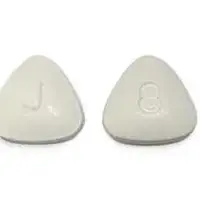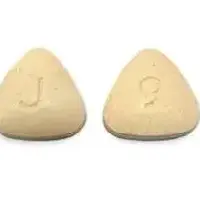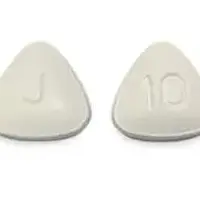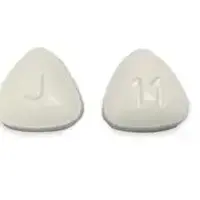What is Nebivolol hydrochloride (monograph)?
Introduction
β-adrenergic blocking agent (β-blocker).
Uses for Nebivolol Hydrochloride
Hypertension
Management of hypertension (alone or in combination with other classes of antihypertensive agents).
β-Blockers generally not preferred for first-line therapy of hypertension according to current evidence-based hypertension guidelines, but may be considered in patients who have a compelling indication (e.g., prior MI, ischemic heart disease, heart failure) for their use or as add-on therapy in those who do not respond adequately to the preferred drug classes (ACE inhibitors, angiotensin II receptor antagonists, calcium-channel blockers, or thiazide diuretics). A 2017 ACC/AHA multidisciplinary hypertension guideline states that β-blockers used for ischemic heart disease that are also effective in lowering BP include bisoprolol, carvedilol, metoprolol succinate, metoprolol tartrate, nadolol, propranolol, and timolol.
Individualize choice of therapy; consider patient characteristics (e.g., age, ethnicity/race, comorbidities, cardiovascular risk) as well as drug-related factors (e.g., ease of administration, availability, adverse effects, cost).
The 2017 ACC/AHA hypertension guideline classifies BP in adults into 4 categories: normal, elevated, stage 1 hypertension, and stage 2 hypertension. (See Table 1.)
Source: Whelton PK, Carey RM, Aronow WS et al. 2017 ACC/AHA/AAPA/ABC/ACPM/AGS/APhA/ASH/ASPC/NMA/PCNA guideline for the prevention, detection, evaluation, and management of high blood pressure in adults: a report of the American College of Cardiology/American Heart Association Task Force on Clinical Practice Guidelines. Hypertension. 2018;71:e13-115.
Individuals with SBP and DBP in 2 different categories (e.g., elevated SBP and normal DBP) should be designated as being in the higher BP category (i.e., elevated BP).
|
Category |
SBP (mm Hg) |
DBP (mm Hg) |
|
|---|---|---|---|
|
Normal |
<120 |
and |
<80 |
|
Elevated |
120–129 |
and |
<80 |
|
Hypertension, Stage 1 |
130–139 |
or |
80–89 |
|
Hypertension, Stage 2 |
≥140 |
or |
≥90 |
The goal of hypertension management and prevention is to achieve and maintain optimal control of BP. However, the BP thresholds used to define hypertension, the optimum BP threshold at which to initiate antihypertensive drug therapy, and the ideal target BP values remain controversial.
The 2017 ACC/AHA hypertension guideline generally recommends a target BP goal (i.e., BP to achieve with drug therapy and/or nonpharmacologic intervention) <130/80 mm Hg in all adults regardless of comorbidities or level of atherosclerotic cardiovascular disease (ASCVD) risk. In addition, an SBP goal of <130 mm Hg generally is recommended for noninstitutionalized ambulatory patients ≥65 years of age with an average SBP of ≥130 mm Hg. These BP goals are based upon clinical studies demonstrating continuing reduction of cardiovascular risk at progressively lower levels of SBP.
Other hypertension guidelines generally have based target BP goals on age and comorbidities. Guidelines such as those issued by the JNC 8 expert panel generally have targeted a BP goal of <140/90 mm Hg regardless of cardiovascular risk and have used higher BP thresholds and target BPs in elderly patients compared with those recommended by the 2017 ACC/AHA hypertension guideline.
Some clinicians continue to support previous target BPs recommended by JNC 8 due to concerns about the lack of generalizability of data from some clinical trials (e.g., SPRINT study) used to support the 2017 ACC/AHA hypertension guideline and potential harms (e.g., adverse drug effects, costs of therapy) versus benefits of BP lowering in patients at lower risk of cardiovascular disease.
Consider potential benefits of hypertension management and drug cost, adverse effects, and risks associated with the use of multiple antihypertensive drugs when deciding a patient's BP treatment goal.
For decisions regarding when to initiate drug therapy (BP threshold), the 2017 ACC/AHA hypertension guideline incorporates underlying cardiovascular risk factors. ASCVD risk assessment is recommended by ACC/AHA for all adults with hypertension.
ACC/AHA currently recommend initiation of antihypertensive drug therapy in addition to lifestyle/behavioral modifications at an SBP ≥140 mm Hg or DBP ≥90 mm Hg in adults who have no history of cardiovascular disease (i.e., primary prevention) and a low ASCVD risk (10-year risk <10%).
For secondary prevention in adults with known cardiovascular disease or for primary prevention in those at higher risk for ASCVD (10-year risk ≥10%), ACC/AHA recommend initiation of antihypertensive drug therapy at an average SBP ≥130 mm Hg or an average DBP ≥80 mm Hg.
Adults with hypertension and diabetes mellitus, chronic kidney disease (CKD), or age ≥65 years are assumed to be at high risk for cardiovascular disease; ACC/AHA state that such patients should have antihypertensive drug therapy initiated at a BP ≥130/80 mm Hg. Individualize drug therapy in patients with hypertension and underlying cardiovascular or other risk factors.
In stage 1 hypertension, experts state that it is reasonable to initiate drug therapy using the stepped-care approach in which one drug is initiated and titrated and other drugs are added sequentially to achieve the target BP. Initiation of antihypertensive therapy with 2 first-line agents from different pharmacologic classes recommended in adults with stage 2 hypertension and average BP >20/10 mm Hg above BP goal.
Black hypertensive patients generally tend to respond better to monotherapy with calcium-channel blockers or thiazide diuretics than to β-blockers. However, diminished response to β-blockers is largely eliminated when administered concomitantly with a thiazide diuretic.
Related/similar drugs
amlodipine, lisinopril, metoprolol, losartan, furosemide, hydrochlorothiazideNebivolol Hydrochloride Dosage and Administration
General
-
Individualize dosage according to patient response.
-
If long-term therapy is discontinued, reduce dosage gradually over a period of about 1–2 weeks. (See Abrupt Withdrawal of Therapy under Cautions.)
-
β1-Adrenergic blocking selectivity diminishes as dosage is increased beyond 10 mg.
BP Monitoring and Treatment Goals
-
Monitor BP regularly (i.e., monthly) during therapy and adjust dosage of the antihypertensive drug until BP controlled.
-
If unacceptable adverse effects occur, discontinue drug and initiate another antihypertensive agent from a different pharmacologic class.
-
If adequate BP response not achieved with a single antihypertensive agent, either increase dosage of single drug or add a second drug with demonstrated benefit and preferably a complementary mechanism of action (e.g., ACE inhibitor, angiotensin II receptor antagonist, calcium-channel blocker, thiazide diuretic). Many patients will require ≥2 drugs from different pharmacologic classes to achieve BP goal; if goal BP still not achieved, add a third drug.
Administration
Oral Administration
Administer orally once daily without regard to meals.
Frequent administration (i.e., daily divided doses) unlikely to be more beneficial than once-daily administration.
Dosage
Available as nebivolol hydrochloride; dosage expressed in terms of nebivolol.
Adults
Hypertension
Oral
Initially, 5 mg once daily, either alone or in combination with other antihypertensives. Increase at 2-week intervals (up to 40 mg daily) in patients whose BP is uncontrolled with the initial dosage. Some experts state usual dosage range is 5–40 mg once daily.
Prescribing Limits
Adults
Hypertension
Oral
Maximum 40 mg daily.
Special Populations
Hepatic Impairment
Initially, 2.5 mg once daily in patients with moderate hepatic impairment (Child-Pugh class B). Increase dosage carefully, if necessary.
Contraindicated in patients with severe hepatic impairment (Child-Pugh class C). (See Contraindications under Cautions.)
Renal Impairment
Initially, 2.5 mg once daily in patients with severe renal impairment (Clcr <30 mL/minute). Increase dosage carefully, if necessary.
Geriatric Patients
Dosage adjustment not required.
Poor CYP2D6 Metabolizers
No dosage adjustment required in poor metabolizers of CYP2D6 substrates.
Warnings
Contraindications
-
Severe bradycardia.
-
Heart block greater than first degree.
-
Cardiogenic shock.
-
Decompensated cardiac failure. (See Heart Failure under Cautions.)
-
Sick sinus syndrome (unless a functioning permanent pacemaker is present).
-
Severe hepatic impairment (Child-Pugh class C).
-
Known hypersensitivity to nebivolol or any ingredient in the formulation.
Warnings/Precautions
Warnings
Abrupt Withdrawal of Therapy
Abrupt discontinuance of therapy is not recommended as it may exacerbate angina symptoms or precipitate MI and ventricular arrhythmias in patients with CAD. Gradually decrease dosage over a period of about 1–2 weeks; monitor patients carefully and advise patients to temporarily limit their physical activity during withdrawal of therapy. If exacerbation of angina occurs or acute coronary insufficiency develops, reinstitute therapy (at least temporarily).
Heart Failure
Possible precipitation of heart failure.
Avoid use in patients with overt heart failure; use cautiously in patients with inadequate cardiac function and, if necessary, in patients with well-compensated heart failure. If heart failure worsens, consider discontinuing therapy.
Ischemic Heart Disease
Safety and efficacy in patients with angina pectoris or recent MI have not been established.
Major Surgery
Possible increased risks associated with general anesthesia (e.g., severe hypotension, difficulty in restarting or maintaining a heart beat) have occurred in some patients who received β-blockers. Use with caution in patients undergoing major surgery involving general anesthesia, especially with myocardial-depressant anesthetics (e.g., cyclopropane, ether, trichloroethylene).
Effects of β-blockers can be reversed by administration of β-agonists (e.g., dobutamine, isoproterenol).
Bronchospastic Disease
Possible bronchospasm. Generally should not be used in patients with bronchospastic disease.
Diabetes Mellitus and Hypoglycemia
Possible decreased signs and symptoms of hypoglycemia (e.g., tachycardia) and increased insulin-induced hypoglycemia.
Use with caution in patients with history of spontaneous hypoglycemia and in patients with diabetes receiving hypoglycemic agents.
Thyrotoxicosis
Signs of hyperthyroidism (e.g., tachycardia) may be masked. Possible exacerbation of hyperthyroidism or thyroid storm if therapy is abruptly withdrawn.
Peripheral Vascular Disease
Possible precipitation or aggravation of arterial insufficiency. Use with caution.
Interactions
Concomitant use with nondihydropyridine calcium-channel blocking agents (e.g. verapamil, diltiazem) requires caution. (See Specific Drugs under Interactions.)
General Precautions
Risk of Anaphylactic Reactions
Patients with a history of anaphylactic reactions to a variety of allergens may be more reactive to repeated accidental, diagnostic, or therapeutic challenges with allergens while taking β-blockers. Such patients may be unresponsive to usual doses of epinephrine.
Pheochromocytoma
Use with caution in patients suspected of having pheochromocytoma; initiate therapy with α-adrenergic blocking agent before using any β-blocker.
Specific Populations
Pregnancy
Category C.
Lactation
Distributed into milk in rats; not known whether distributed into human milk. Discontinue nursing or drug.
Pediatric Use
Safety and efficacy not established in children <18 years of age.
Geriatric Use
No substantial differences in safety or efficacy relative to younger adults.
Hepatic Impairment
Decreased clearance in patients with moderate hepatic impairment (Child-Pugh class B); use with caution. (See Hepatic Impairment under Dosage and Administration.)
Safety and efficacy not established in patients with severe hepatic impairment (Child-Pugh class C); use is contraindicated in these patients. (See Contraindications.)
Renal Impairment
Decreased clearance in patients with severe renal impairment (Clcr <30 mL/minute); use with caution. (See Renal Impairment under Dosage and Administration.)
Not specifically studied in patients undergoing dialysis; use with caution in these patients.
Common Adverse Effects
Headache, fatigue, dizziness, diarrhea, nausea.
How should I use Nebivolol hydrochloride (monograph)
General
-
Individualize dosage according to patient response.
-
If long-term therapy is discontinued, reduce dosage gradually over a period of about 1–2 weeks. (See Abrupt Withdrawal of Therapy under Cautions.)
-
β1-Adrenergic blocking selectivity diminishes as dosage is increased beyond 10 mg.
BP Monitoring and Treatment Goals
-
Monitor BP regularly (i.e., monthly) during therapy and adjust dosage of the antihypertensive drug until BP controlled.
-
If unacceptable adverse effects occur, discontinue drug and initiate another antihypertensive agent from a different pharmacologic class.
-
If adequate BP response not achieved with a single antihypertensive agent, either increase dosage of single drug or add a second drug with demonstrated benefit and preferably a complementary mechanism of action (e.g., ACE inhibitor, angiotensin II receptor antagonist, calcium-channel blocker, thiazide diuretic). Many patients will require ≥2 drugs from different pharmacologic classes to achieve BP goal; if goal BP still not achieved, add a third drug.
Administration
Oral Administration
Administer orally once daily without regard to meals.
Frequent administration (i.e., daily divided doses) unlikely to be more beneficial than once-daily administration.
Dosage
Available as nebivolol hydrochloride; dosage expressed in terms of nebivolol.
Adults
Hypertension
Oral
Initially, 5 mg once daily, either alone or in combination with other antihypertensives. Increase at 2-week intervals (up to 40 mg daily) in patients whose BP is uncontrolled with the initial dosage. Some experts state usual dosage range is 5–40 mg once daily.
Prescribing Limits
Adults
Hypertension
Oral
Maximum 40 mg daily.
Special Populations
Hepatic Impairment
Initially, 2.5 mg once daily in patients with moderate hepatic impairment (Child-Pugh class B). Increase dosage carefully, if necessary.
Contraindicated in patients with severe hepatic impairment (Child-Pugh class C). (See Contraindications under Cautions.)
Renal Impairment
Initially, 2.5 mg once daily in patients with severe renal impairment (Clcr <30 mL/minute). Increase dosage carefully, if necessary.
Geriatric Patients
Dosage adjustment not required.
Poor CYP2D6 Metabolizers
No dosage adjustment required in poor metabolizers of CYP2D6 substrates.
What other drugs will affect Nebivolol hydrochloride (monograph)?
Metabolized by CYP2D6; does not inhibit CYP isoenzymes at clinically relevant concentrations.
Drugs Affecting Hepatic Microsomal Enzymes
CYP2D6 inhibitors: Potential increased plasma nebivolol concentrations; monitor patients carefully and adjust dosage according to BP response.
Specific Drugs
|
Drug |
Interaction |
Comments |
|---|---|---|
|
Antiarrhythmic agents (e.g., amiodarone, disopyramide) |
Possible conduction disturbances |
Use concomitantly with caution |
|
Antidiabetic agents (oral) |
May mask symptoms of hypoglycemia (e.g., tachycardia) |
Use concomitantly with caution |
|
β-Blockers |
Possible additive effects |
Concomitant use with other β-blockers not recommended |
|
Calcium-channel blocking agents, nondihydropyridine (e.g., diltiazem, verapamil) |
Possible conduction disturbances |
Use concomitantly with caution; monitor BP and ECG with concomitant use |
|
Catecholamine-depleting agents (e.g., guanethidine, reserpine) |
Potential additive effects (e.g., hypotension, bradycardia) |
Monitor closely for symptoms (e.g., vertigo, syncope, postural hypotension) |
|
Charcoal (activated) |
Pharmacokinetic interaction unlikely |
|
|
Cimetidine |
Potential increased plasma nebivolol concentrations No apparent change in pharmacodynamics of nebivolol (e.g., BP, heart rate) |
|
|
Clonidine |
Potential for increased rebound hypertension following discontinuance of clonidine |
If used concurrently, discontinue nebivolol therapy several days before clonidine therapy is to be gradually discontinued |
|
Digoxin |
Possible additive negative effects on AV conduction and heart rate; increased risk of bradycardia Concomitant use did not affect pharmacokinetics of digoxin or nebivolol |
Use concomitantly with caution |
|
Diuretics (e.g., furosemide, hydrochlorothiazide, spironolactone) |
Pharmacokinetic interactions unlikely |
|
|
Fluoxetine |
Potential increased plasma nebivolol concentrations |
Use concomitantly with caution |
|
Insulin |
May mask symptoms of hypoglycemia (e.g., tachycardia) |
Use concomitantly with caution |
|
Losartan |
Pharmacokinetic interaction unlikely |
|
|
Myocardial-depressant general anesthetics (e.g., cyclopropane, ether, trichloroethylene) |
Increased risk of hypotension and difficulty in restarting or maintaining heartbeat |
Closely monitor with concomitant use |
|
Paroxetine |
Potential increased plasma nebivolol concentrations |
Use concomitantly with caution |
|
Propafenone |
Potential increased plasma nebivolol concentrations |
Use concomitantly with caution |
|
Quinidine |
Potential increased plasma nebivolol concentrations |
Use concomitantly with caution |
|
Ramipril |
Pharmacokinetic interaction unlikely |
|
|
Ranitidine |
Pharmacokinetic interaction unlikely; no apparent change in pharmacodynamics of nebivolol (e.g., BP, heart rate) |
|
|
Sildenafil |
Additive effects on BP and pulse Potential decreased peak plasma concentrations of sildenafil; modest effect on peak plasma concentration and AUC of d-nebivolol |
|
|
Warfarin |
No effect on PT or warfarin pharmacokinetics observed |







